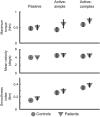Predictive modeling by the cerebellum improves proprioception
- PMID: 24005283
- PMCID: PMC3761044
- DOI: 10.1523/JNEUROSCI.0784-13.2013
Predictive modeling by the cerebellum improves proprioception
Abstract
Because sensation is delayed, real-time movement control requires not just sensing, but also predicting limb position, a function hypothesized for the cerebellum. Such cerebellar predictions could contribute to perception of limb position (i.e., proprioception), particularly when a person actively moves the limb. Here we show that human cerebellar patients have proprioceptive deficits compared with controls during active movement, but not when the arm is moved passively. Furthermore, when healthy subjects move in a force field with unpredictable dynamics, they have active proprioceptive deficits similar to cerebellar patients. Therefore, muscle activity alone is likely insufficient to enhance proprioception and predictability (i.e., an internal model of the body and environment) is important for active movement to benefit proprioception. We conclude that cerebellar patients have an active proprioceptive deficit consistent with disrupted movement prediction rather than an inability to generally enhance peripheral proprioceptive signals during action and suggest that active proprioceptive deficits should be considered a fundamental cerebellar impairment of clinical importance.
Figures



References
-
- Adamovich SV, Berkinblit MB, Fookson O, Poizner H. Pointing in 3D space to remembered targets. I. Kinesthetic versus visual target presentation. J Neurophysiol. 1998;79:2833–2846. - PubMed
-
- Arezzo JC, Schaumburg HH, Laudadio C. The Vibratron: a simple device for quantitative evaluation of tactile/vibratory sense. Neurology. 1985;35:169.
-
- Bastian AJ, Zackowski KM, Thach WT. Cerebellar ataxia: torque deficiency or torque mismatch between joints? J Neurophysiol. 2000;83:3019–3030. - PubMed
Publication types
MeSH terms
Grants and funding
LinkOut - more resources
Full Text Sources
Other Literature Sources
Medical
